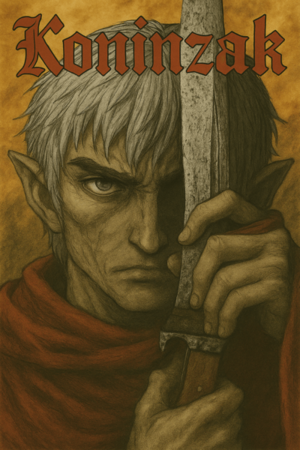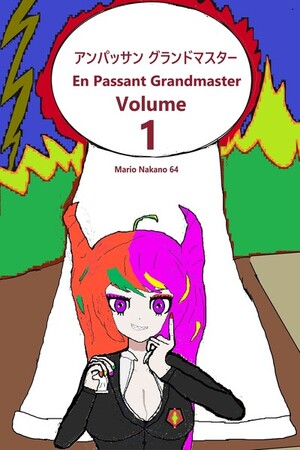Chapter 7:
Finding a way during crisis
Koninzak
Back in the day when Albar and Aremfrid’s grandfather ruled the tribe, he sent out his son Dagmulric to lead a military campaign against the Toretanii tribe. Too arrogant to listen to the advice of his veterans and chiefs, Dagmulric ordered his forces to fight an uphill battle against a dug-in enemy, causing him a devastating loss. It is because of this mistake born out of arrogance and insecurity that the Ausmulii Highgoblins refused to pledge fealty to Albar’s father, for they could not entrust someone so flawed to hold sway over them through a complete Edekrag.
The Edekrag is a power that comes with being a higher stage of goblin. This force allows the ascended goblin to exert his authority over those beneath him by emitting a subtle compulsion that encourages cohesion and obedience. The more advanced the goblin is, the stronger its Edekrag is. Goblins will defer to Hobgoblins, who defer to Crawgoblins, who defer to Highgoblins, who, in turn, defer to their Gnobble. The full potential of the Edekrag is wielded by the Gnobbles who use it hold together the tribe they rule. It does not force loyalty, but amplifies respect and trust instead.
The higher ascended and more intelligent a goblin is, the less it affects them. A Hobgoblin will feel bound to his Gnobble with his life, whereas a Highgoblin is merely pulled to respect his Gnobble. Either way, the power is highly effective in holding together a tribe, instilling stability and tranquility within the heart of a goblin.
In the past, before there were any goblins who reached Gnobblehood, a tribe’s sophistication could be measured by who stood at the top. A tribe led by a Hobgoblin was clearly still rudimentary, whereas a tribe led by a Highgoblin was well-developed.
However, goblins are not at the mercy of their biological inclination towards deference. If their leader, whether they be a Hobgoblin or a Goblin King, repeatedly fails to live up to expectations, the Edekrag will fall flat, and the goblins will no longer feel any respect nor loyalty to their lord, leading to rebellion.
***
After the chieftain shot down Kelmun’s objection, he allowed the emissary to speak up once more. The emissary from the Laiesyces dual-tribe came with an offer of peace between their two tribes.
In the decentralized hills of Gobland, villages would often organize skirmishes, raids, and expeditions into neighboring villages of rival tribes, aiming to seize wealth and plunder resources as their own warriors were provided with combat practice. While conquest was not the objective, and full-scale war was rare, the Laiesyces dual-tribe has grown weary of these conflicts. Now, they seek to assert their sovereignty and live free from the encroachment of other tribes.
As such, the emissary proposed a political marriage between Albar Habzakii and Gildnund Lohe, the daughter of one of the Laiesyces diarchs, cementing a tribal alliance that would prevent raids amongst themselves, as well as deterring outside raiders, lest they meet the ire of two powerful tribes.
Foreboding days followed Albar’s marriage and the commencement of the tribal alliance. As disputes ramped up and conciliation delayed, the brooding unrest in Gobland would soon boil over.
Dread lynxes. Ravenous, large felines who prey on human and animal alike, were driven off their homelands in the thousands by a new pack of canine monsters. They fled to Gobland and the human realms bordering it, as they exterminated local fauna and chased away man and goblin from their sedentary lives. The human realms, with their developed institutions and technology, could ward them off with ease. Royal and noble retinues could traverse the brick roads and quickly hunt down lynxes with quality pikes and blades, just as the Bondhouses and Adventurers Guilds could employ freelance warriors to do the same. The scattered, backwater goblins, on the other hand, could not withstand as dread lynxes come marching into their farms and villages, devouring crops and livestock alike.
Discord and strife began to plague the goblins more than the lynxes themselves, as they began to squabble over which person was entitled to which land. Herders turned nomads, and destitute farmers, repelled from their grazing and farmlands, sought to homestead elsewhere, crossing tribal borders and settling near villages of different customs. Constant migrations begin to erode the old boundaries, both politically and culturally.
Villages encroach on each other’s hunting grounds as hunting rights become a political topic of friction. With an already declining amount of wild game, the debates surrounding the hunting rights only worsen the lack of resources.
“Do abandoned farms revert to the tribe or can squatters claim them?” Louds one public debate. In response to this query, the most powerful goblin tribe, the Turacetae, claimed all their undeveloped land as their ruler’s private property, whereby both homesteading and squatting were practically criminalized. The Bugretanii believed that undeveloped land was free picking for whoever came first, but already developed land should revert to the nearest village, leading to further disputes about which village was the nearest to said developed land. The Ausmulii adopted a policy whereby every upcoming settlement of newcomers had to be approved by the high chief or face destruction. And thus, intra-tribal quarrels, especially with regard to ownership and property, could not be resolved as tribes differed in legal systems, definitions, and customs. What one regarded as rightful ownership, the other viewed as usurpation and theft.
As the warriors of each tribe busy themselves with fending off the invading dread lynxes, banditry becomes an easy way for newly destitute goblins to make a living. Law enforcement as well as the courts slowly collapse as the old system breaks down.
It is in this context that two Bondhouses from the human kingdom of Lugustia dispatched a combined party of apprentice wayfinders alongside veterans to the capital town of the Ausmulii. With the goblins in disarray, attacking a goblin stronghold would yield great experience for both apprentices and veterans, and because most humans do not recognize goblinkind as an equal, they would get anything but scorn for wiping out a town of their kind.
In the attack, the chieftain and his two sons stood out the most. The wayfinders totaled a hunderd warriors, of which half were veterans, and the father-sons trio vanquished five veterans and eight apprentices, while the rest of the goblin forces killed a combined total of twenty-three wayfinders. The human party had not expected to sustain these casualties; such was the strength of the chieftain and his sons, of two Gobkins and a Highgoblin, who competently led a nevertheless disorganized band.
The Ausmulii high chief was killed in battle, while both his sons were imprisoned and shipped back to the human kingdom of Lugustia. With the help of his younger brother, however, Albar escaped and made his way back to his people to take charge of his tribe and rectify their state. Upon his return, the Highgoblins were apprehensive about pledging their fealty to Albar, who had come to power through a devastating loss to the tribe. They made him their chieftain, just like they did with his father, but withheld their pledge until a good omen regarding him would come. Once someone became ruler of a tribe, they would be granted the honor name “ric”, meaning “ruler”. For Albar, however, they waived this tradition until the arrival of a good omen as well.
Aremfrid was enslaved in the kingdom of Lugustia, and would only return to Gobland after nineteen years of servitude.




Please sign in to leave a comment.